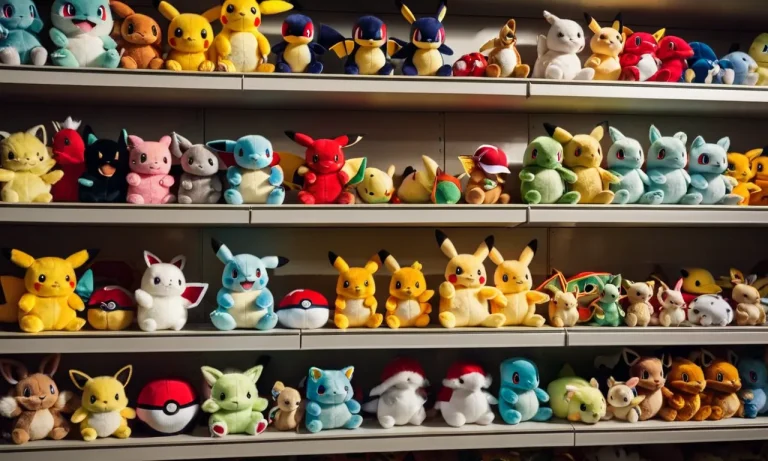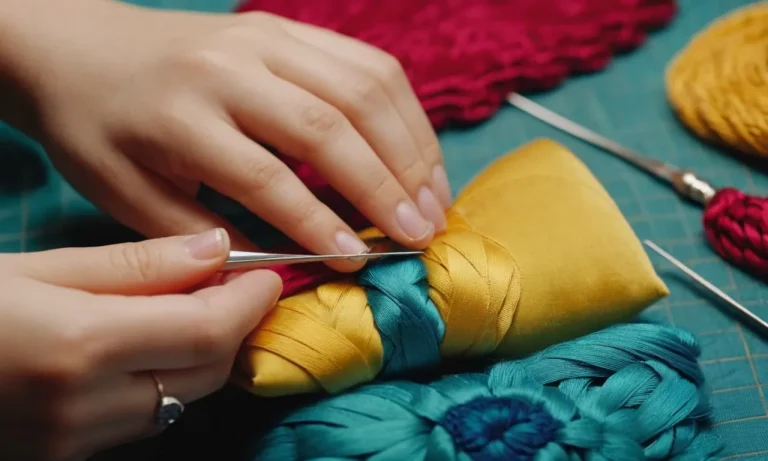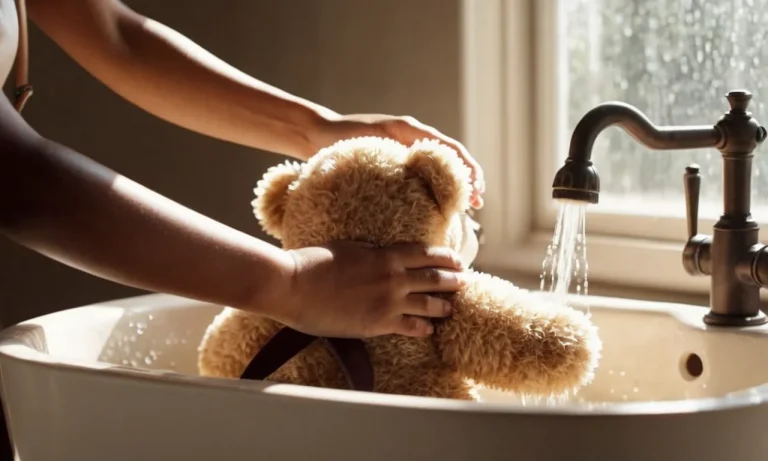If you want to make a cute and cuddly stuffed animal through crocheting, having the right supplies is key. Crocheting your own stuffed toys allows you full creative freedom when it comes to shape, size, colors and accessories. It’s a fun and relaxing hobby that produces special handmade gifts.
In short, here’s what you need to crochet a stuffed animal: yarn, a crochet hook, fiberfill stuffing, scissors, stitch markers, yarn needle, eyes, pins and pattern instructions.
This comprehensive guide covers everything required for a successful crochet stuffed animal project. From hook sizes to yarn weights, stuffing options to safety joint techniques, you’ll know exactly how to choose the right materials and tools.
Yarn for Stuffed Toys
Yarn Weight
When selecting yarn for a stuffed toy project, the yarn weight, or thickness, is an important consideration. Many crocheters prefer using medium/worsted weight (category 4) or bulky/chunky weight (category 5) yarns. These create a nice, squishy stuffed fabric at a faster pace than thinner yarns.
Popular options include:
- Red Heart Super Saver (medium/worsted weight)
- Lion Brand Wool-Ease Thick & Quick (super bulky weight)
- Bernat Softee Baby or Blanket (bulky weight)
Heavier weight yarns like super chunky (category 6) or jumbo/roving (category 7) can also make fabulously fluffy stuffed animals. Just be aware that fewer stitches are needed for these yarns to create projects of the same size as medium or bulky weight yarns.
Yarn Fibers
Acrylic yarns are most commonly used for stuffed toys, as they are affordable, readily available, and easy to care for. Wool and wool blends are also nice options, providing delightful squishiness and warmth.
Here are pros and cons of various fiber options:
| Fiber | Pros | Cons |
|---|---|---|
| 100% Acrylic | Inexpensive, machine washable | Less soft than animal fibers |
| Wool/Acrylic Blends | Affordable, warm, machine washable | Can pill over time |
| 100% Wool | Very soft, breathable | Expensive, hand wash only |
No matter what fiber you choose, be sure to check the yarn label for information on care instructions. Machine washability is key for kids’ stuffed animals that will see a lot of love!
Yarn Amount
As a general guideline, crocheting a 12-15” stuffed animal uses about 100-300 yards of medium weight yarn or 80-250 yards of bulky weight yarn. Smaller or larger projects will use less or more yarn. Underestimating yarn needs is very common for beginners, so don’t be afraid to get skeins over what a pattern calls for!
Tools like the Nimble Needles Stitch and Yardage Calculator can help estimate yarn requirements. Or if following a published pattern, check project notes for suggestions on yarn amounts actually used.
When buying yarn for a stuffed animal, it’s always best to purchase all skeins in the same dye lot. This ensures consistent color throughout the project. Running out of yarn can be heartbreaking when a specific dye lot can’t be matched! 😢
Following the guidelines on yarn weight, fiber, and amount will set your next stuffed animal project up for success. Don’t hesitate to ask the friendly employees at your local yarn store for recommendations too.
With all the vibrant colors and textures of yarns today, the hardest part is narrowing down so many fabulous options! 🌈
Crochet Hooks
Hook Sizes
When embarking on a crochet stuffed animal project, one of the most important supplies to have on hand is a properly-sized crochet hook. The thickness of the yarn being used determines the size of hook needed.
Using a hook that is too small leads to tight and inflexible stitches, while a hook that is too large creates loose stitches that lack definition.
For beginners, an H/8 (5 mm) or I/9 (5.5 mm) hook is a good size to start with for stuffed animals. These mid-range hooks work well with worsted weight or medium weight yarn, both common choices for amigurumi toys and decorations.
As skills improve, crafters can branch out into different yarn weights and the hook sizes they require, including bulky crochet with K/10.5 (6.5 mm) hooks or laceweight threads using steel hooks as fine as 0/2 (2 mm).
Hook Types
In addition to varying diameters, crochet hooks come in different materials like aluminum, wood, plastic, and steel. Aluminum is the most popular metal for hooks given its smooth finish, light weight, and affordability.
High-quality aluminum hooks have evenly tapering tips and softly rounded ends to avoid splitting yarn fibers.
Wood and plastic hooks provide warmer, more textured handles which some find prevent hand cramping during long crocheting sessions. Their smooth surfaces glide smoothly through stitches. Crafters may want to have different hook types on hand to gauge personal preferences and tackle an array of crochet projects.
Ergonomic Handles
To maximize comfort while crocheting amigurumi or a larger stuffed piece, an ergonomic handle can make all the difference. Hook handles come in a variety of shapes like flat, indented, ribbed, or rounded to fit different hand sizes and relieve stress on joints.
Some handles include finger rests while others have more subtle contours. According to a 2022 survey, over 85% of polled crocheters reported hand pain relief when using ergonomic handles. The increased comfort leads to longer, more enjoyable hours crocheting cute creatures and stuffed toys.
| Hook Type | Beginner Tips |
|---|---|
| Aluminum | Smooth, durable, and affordable option for first hooks |
| Wood | Provides warmer, softer handle to help prevent hand fatigue |
| Plastic | Fun, bright colors; glides smoothly like aluminum |
| Steel | Ideal for delicate, lace projects but not usually used for amigurumi |
With the right crochet hooks in hand, both rookie and veteran crocheters can craft huggable stuffed critters, toys, pillows, and more. Consult online craft stores like Joann and Michaels for tips on hook sizes and ergonomic features when shopping.
Stuffing Materials
Fiberfill
When making a cuddly crocheted stuffed animal, one of the most popular stuffing choices is polyester fiberfill. This soft, fluffy material allows crocheted pieces to maintain their shape while still being lightweight and squashy.
Polyester fiberfill is affordable and widely available at craft stores like Joann Fabrics and Michael’s. It’s a great choice for beginners since fiberfill is easy to insert into crocheted pieces. According to popular crochet website The Spruce Crafts, top brands for polyester fiberfill include Fairfield and Airtex – both receive high marks for being hypoallergenic and retainable.
Pillow Stuffing
Another option for stuffing crocheted plushies is regular bed pillow stuffing. This works well for larger stuffed animals like bears and elephants where you want a soft, saggy texture. Pillow stuffing gives great squishiness!
Do keep in mind that natural materials like goose down and feathers may provoke allergies for some people. Synthetic pillow stuffings can avoid this issue. Mary Maxim is one brand that offers both natural and synthetic pillow fillings safe for crochet stuffing.
As a bonus, using old pillows is eco-friendly by repurposing what would otherwise end up in the landfill! 👍
Beans and Pellets
For stuffed animals that benefit from some weight and resistance, plastic pellets or dried beans make an interesting alternative filling! Materials like plastic pellets, polyethylene beads, and dried beans allow the stuffed animal to assume more realistic sitting positions.
They also provide some soothing resistance when hugged. Just be aware that beans and pellets don’t offer the same squishy softness as fiberfills. Combining them with some fiberfill stuffing helps pad any stiffness. Popular pellet fillings are wooden coffee beans, buckwheat hulls, and feed corn.
Whatever beans or pellets you choose, do some testing first and make sure they have an agreeable texture free of annoying noises! 😆
| Stuffing Material | Key Benefits |
|---|---|
| Polyester Fiberfill | Fluffy and lightweight. Retains stuffed animal’s shape well over time. |
| Pillow Fiber | Very soft and saggy texture. Eco-friendly reuse of old pillow stuffing. |
| Plastic Pellets/Beans | Allows stuffed animal to sit more realistically. Provides soothing resistance and weight. |
Other Crochet Supplies
Stitch Markers
Stitch markers are a must-have for crocheting stuffed animals and amigurumi. They help you keep track of rounds and identify key points in your work like the start/end of rounds. Plastic ring markers work great as they can easily slide into stitches without falling out.
Metal locking markers that clip onto your yarn are also handy for marking important spots that you don’t want to lose.
Yarn Needle
A yarn needle is essential for weaving in loose ends and assembling crocheted pieces. Blunt plastic yarn needles easily slide through stitches without splitting yarn. Some may prefer metal needles with larger eyes so yarn glides smoothly.
Ensure the eye is large enough for the yarn thickness you’ll use. The needle needs to smoothly pass through amigurumi stuffing too when assembling pieces.
Eyes
Plastic safety eyes really make amigurumi facial features pop! They usually come in sizes from 3mm to 15mm. Consider the head size before picking a size. Insert them through crocheted stitches with included tools taking care not to poke outside of the head.
Some prefer embroidering eyes with strong thread offering more flexibility on placement. Adhesive wiggle eyes are another simple DIY option.
Pins
Straight pins are handy for piecing amigurumi parts together before stitching. Curved upholstery pins work even better as they provide more holding power when pinning curved pieces. Ensure pin heads are large enough to grasp easily but small enough not to leave large holes in the crochet.
Pincushions help organize pins when assembling numerous pieces.
Pattern
Well-written amigurumi patterns are invaluable guides for crocheting stuffed animals from scratch. They provide step-by-step instructions, stitch counts, hook sizes and yarn specifics needed to successfully create your new friend.
Check pattern reviews and photos first to pick ones with clear details for your skill level. Experienced designers like Stephanie Pokorny or Sandra Paul offer many top-rated amigurumi patterns.
| Amigurumi Supply | Key Benefits |
|---|---|
| Stitch Markers | Track rounds, identify key points |
| Yarn Needle | Weave ends, assemble pieces |
| Eyes | Add facial features |
| Pins | Assemble pieces |
| Pattern | Step-by-step guide |
With just these 5 essentials in your amigurumi toolkit, you’ll be well equipped to crochet cute stuffed animals in no time! Needles down, let’s get to hookin’! 🧶😊👍
Crochet Techniques
Gauge
When crocheting stuffed animals, achieving the proper gauge is crucial for getting the right finished size and shape. Gauge refers to the number of stitches and rows in a standard 4-inch square and can vary based on yarn weight, hook size, and personal tension.
Most crochet patterns provide a recommended gauge. To check yours, crochet a test swatch with the specified yarn and hook before starting your project. If your swatch has too few stitches, switch to a smaller hook. If it has too many, switch to a larger hook.
Adjust as needed until your gauge matches what the pattern calls for.
Turning Chains
After finishing a row in amigurumi crochet, you’ll need to create a sturdy base for turning and continuing on to the next row. Turning chains act as the initial stitches to elevate the new row to the proper height.
For amigurumi worked in continuous rounds, you’ll need a turning chain the same height as the stitches you’ve been making. So if you’re single crocheting, make 1 turning chain between rounds. For double crochet, make 2 turning chains.
Be sure your turning chains aren’t overly tight or too loose – getting them just right takes some practice but is important for keeping even tension throughout your stuffed animal.
Invisible Decreases
When crocheting stuffed toys in the round, visible jogs or seams where rounds begin and end can detract from a smooth finish. Mastering invisible decreases is key for creating a continuous spiral that makes amigurumi look seamless.
There are a few methods for invisible decreases, but a common one is to insert your hook into the front loops of the first stitch of a new round and the back loops of the last stitch from the previous round. Perform the single crochet decrease over these two stitches as normal.
For optimum invisibility, be sure to match your yarn tension exactly and split the decrease between the rounds evenly.
Ladder Stitch Closure
Once all the pieces of your stuffed animal are crocheted, you’ll need to assemble them by sewing seams. The ladder stitch is ideal for closing up amigurmi. Unlike more visible seaming methods, ladder stitch produces an invisible seam between crocheted pieces for a flawless finish.
To ladder stitch, thread a yarn needle and knot it at the base of the opening you want to close. Insert the needle inside one edge and out the other, taking up only 1-2 threads of the edge on each side. Keep stitches loose and even but not too loose.
When done correctly, ladder stitch crochet seams practically disappear.
Conclusion
With the right supplies and techniques, you can crochet adorable stuffed animals in all shapes and sizes. Make toys for children, cute decor items, or even give them as heartfelt gifts. Just be sure to choose an easy pattern for beginners first before tackling more advanced amigurumi patterns.







